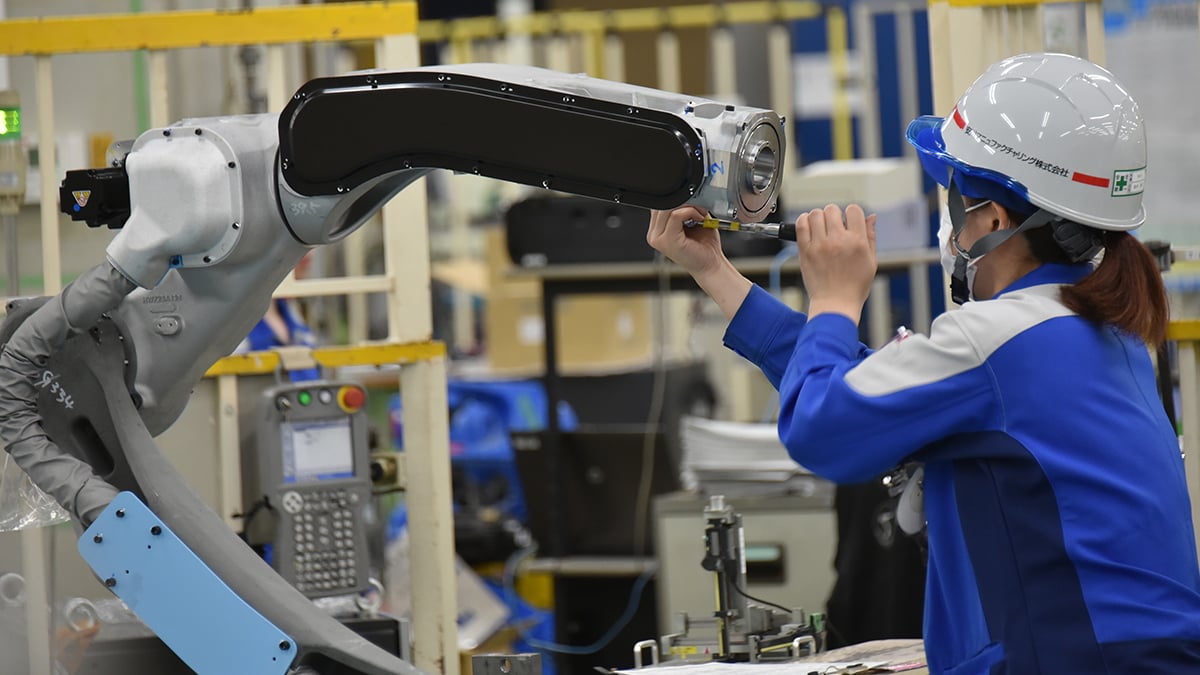When leaders describe how advances in automation will affect job prospects for humans, predictions typically fall into one of two camps. Optimists say that machines will free human workers to do higher-value, more creative work. Pessimists predict massive unemployment, or, if they have a flair for the dramatic, a doomsday scenario in which humans’ only job is to serve our robot overlords.
What almost everyone gets wrong is focusing exclusively on the idea of automation “replacing” humans. Simply asking which humans will be replaced fails to account for how work and automation will evolve. Our new book, Reinventing Jobs: A 4-Step Approach for Applying Automation to Work, argues that while automation can sometimes substitute for human work, it also more importantly has the potential to create new, more valuable, and more fulfilling roles for humans.

The intense emphasis on automation eliminating certain jobs for humans often stems from a fixation on near-term economic outcomes, particularly a focus on a traditional “lift and shift” equation that measures success according to the reduction in labor costs resulting from having fewer workers. While most organizations also look for gains like improvements in speed, quality and service, the focus is still on economic outcomes. Such a narrow focus overlooks some of the most important and vital benefits of optimizing work automation. Indeed, we have found that automation often results in higher compensation for workers, with those costs often being offset by greater productivity. However, the benefits go beyond strict economic accounting. By reinventing jobs to optimize work between humans and automation, organizations can attract a larger and more qualified applicant pool and achieve better retention, greater safety, and increased diversity.
The reinvention of work in the oil and gas industry provides an excellent example of the more nuanced approach to optimized work automation, as well as the array of benefits that lie beyond the more obvious economics of reduced labor costs.
Work Reinvention on the Oil and Gas Rig
Traditionally, oil rig workers must be on-site, doing hands-on, manual labor that is often dangerous. However, rapid advances in technology now make it possible to create a completely autonomous rig. The traditional, economically-motivated way to envision the benefits of this technology is to imagine how many workers doing today’s oil-rig jobs could be removed from the operation if the rigs were fully automated.
In contrast, the CEO and leadership team of one organization that worked with Ravin’s firm, Willis Towers Watson, adopted a more deliberate and inventive strategy. First, they refocused their strategy to provide a more comprehensive extraction solution, envisioning the rig as a platform for services beyond simply drilling a hole in the ground, with automation driving that transformation.
Second, instead of fixating on eliminating human labor, they set out to optimize their human talent, shifting employees away from repetitive, physical, isolated, and dangerous work and toward more variable, mental, interactive, and less hazardous work. They reinvented their rig crews to provide many of the services that before had been provided by third parties, offering a complete oilfield management solution.
Third, they recognized the fundamental value of deconstructing the existing jobs into work activities, to more clearly reveal where automation would eliminate some work, augment other work, and create entirely new work that was previously not possible. The reinvented work activities fell into several categories:
- Activities centralized (sensors and AI monitor operations and transmit data to human workers in a control center)
- Activities shifted to other roles (e.g., maintenance previously done by teams on each rig are shifted to shared-service teams)
- Activities augmented (e.g., AI assists with monitoring rig performance, and sensors allow more precise directional drilling)
- Activities eliminated (e.g., robotics now perform pipe running and other dangerous and dirty work)
- Activities created (e.g., previously lesser skilled rig workers can now perform some electrical/mechanical engineering work)
These newly reinvented jobs required increasing pay levels by between 7% and 15%. A traditionalist aiming to cut labor costs with automation might see that as a losing proposition, but a more complete analysis reveals the benefits that easily offset the increased labor cost.
The Increased Profitability Payoff
Converting the rig into a platform for multiple oil field solutions and optimizing the core drilling performance produced a 45% increase in profitability and a significant reduction in performance variance between rigs. This substantial increase in overall rig profitability easily offset the increased labor cost. That profitability gain was partly due to envisioning the rigs and their workers more strategically — as part of a whole oilfield solution, rather than simply a drilling service for hire — and optimizing the role and impact of human labor. These results are impressive, but this strategic approach to work automation also produced two additional, unexpected gains.
Better Workforce Retention/Attraction
The reinvented jobs required very different skills. For example, the job of a “derrickman” was reinvented into a new job of “technician”; this shift eliminated the need for many basic manual skills, but added several new competencies, such as advanced electrical and mechanical knowledge, and enhanced communication and collaboration skills.
As we noted, acquiring and training workers with these new skills required increasing pay levels between 7% and 15%. The increased pay levels helped address the significant industry challenge of attracting and retaining skilled talent. With the reinvented jobs, this company could better compete for top talent, not only with higher pay, but also with more desirable work, because many dirty and dangerous tasks were automated.
The organization expects to see more highly-skilled job applicants apply, join, and stay.
The Diversity Dividend
The other surprising benefit from automation was an increase in workforce diversity. The traditional rig work was physically demanding, isolated, and dangerous. It attracted and retained workers who were overwhelmingly male, with family situations that allowed them to spend large blocks of time on the rig. After the organization reinvented this work, many activities that formerly were performed almost exclusively by men stationed on rigs in remote locations were now performed in a centralized control room in a major metropolitan area. The applicant and worker pool now included more women, and those with more diverse family situations who possessed the cognitive skills required to perform this reinvented work. The diversity and inclusion of genders, family structures, regions and ethnic backgrounds increased so much that for the first time the organization achieved its long-sought diversity goals.
Beyond the Organization
Debates about the impact of automation will rage on for the foreseeable future, but this example illustrates many positive outcomes available through the careful and collaborative reinvention of jobs. This reinvention is not only vital to optimizing work and automation within a single firm; it is also important for empowering organizations to participate in the social conversation about future job creation and work. Political, social, economic and regulatory debate typically relies on concepts like “good jobs,” “lost jobs,” and “preparing a workforce for the jobs of the future.” By adopting a systematic approach to work automation, organizations can better shape these debates by more clearly illuminating the full array of benefits and costs, both within the organization and for society more broadly.
 Ravin Jesuthasan is Managing Director at Willis Towers Watson. He is a member of the World Economic Forum’s Steering Committee on Work and Employment and has been recognized as one of the 25 most influential consultants in the world. He is the coauthor with John Boudreau of the new book Reinventing Jobs: A 4 Step Approach for Applying Automation to Workand numerous articles on work, automation, and human capital. Follow him on Twitter
Ravin Jesuthasan is Managing Director at Willis Towers Watson. He is a member of the World Economic Forum’s Steering Committee on Work and Employment and has been recognized as one of the 25 most influential consultants in the world. He is the coauthor with John Boudreau of the new book Reinventing Jobs: A 4 Step Approach for Applying Automation to Workand numerous articles on work, automation, and human capital. Follow him on Twitter
Ravin Jesuthasan will join the global AI community as speaker at World Summit AI Americas April 10-11 in Montreal, Canada.
 John Boudreau is Professor of Management Organization at the University of Southern California’s Marshall School of Business and Research Director at the university’s Center for Effective Organizations. He is an expert on the bridge between superior human capital, talent, and sustainable success and the author of many books and articles, including his latest book with Ravin Jesuthasan, Reinventing Jobs: A 4 Step Approach for Applying Automation to Work. Follow him on Twitter at: @JohnWBoudreau.
John Boudreau is Professor of Management Organization at the University of Southern California’s Marshall School of Business and Research Director at the university’s Center for Effective Organizations. He is an expert on the bridge between superior human capital, talent, and sustainable success and the author of many books and articles, including his latest book with Ravin Jesuthasan, Reinventing Jobs: A 4 Step Approach for Applying Automation to Work. Follow him on Twitter at: @JohnWBoudreau.
.png?width=259&name=WSAI%20Amsterdam%20Orange%20no%20dates%202000x300%20(1).png)
.png?width=263&name=IM_Mothership_assets_LOGO_MINT%20(2).png)

